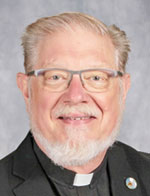That All May Be One / Fr. Rick Ginther
Eiteljorg exhibit reveals lack of ecumenical spirit in early west
 I seldom go to museums, especially art museums. As a strong “sensate” on the Myer-Briggs Personality Type Indicator, when I encounter too much visual information, it overwhelms me.
I seldom go to museums, especially art museums. As a strong “sensate” on the Myer-Briggs Personality Type Indicator, when I encounter too much visual information, it overwhelms me.
It takes about 45 minutes. Brain fatigue sets in. I must leave. I flee to the gift shop, or find a bench upon which to sit, close my eyes, and ruminate.
On Memorial Day, my sister Mary Ginther-Oss, Father Larry Richardt and I went to the Eiteljorg Museum in Indianapolis. We were drawn there by an exhibit both historic and stimulating—“Acts of Faith: Religion and the American West.”
The exhibit attempts to “explore how a diverse range of religious practices shaped the American West and how the American West shaped religion.”
Upon arrival, the three of us went our ways and explored. And what a treasure of discovery it was! I was in the exhibit well beyond 45 minutes—reading, digesting, wondering, learning.
From an ecumenical stance, there were some revealing insights.
Roman Catholic presence grew from St. Louis, California, Texas, New Mexico and Colorado. Our presence was to care for the Catholics journeying west and those who were formerly in the Spanish territories.
Various Protestant denominations were very active as well.
Supporting and encouraging their missionary efforts was the New York City Tract House. Their hope was “to Christianize the West.” Their method, besides sending missionaries, was pamphlets (tracts) it published and the Bibles it sent west by the railcar loads.
In Denver, a former slave named Clara Brown began a successful laundry business among the gold miners. Her Christian upbringing and financial success allowed her to promote Christian life and values.
From an interreligious stance, there were some revealing insights.
The first Jewish congregation in the American west sprang up in St. Louis. This minyan (gathering of 10) grew through time. Other Jewish communities emerged from them, going west.
The forced migration of the Church of Latter-Day Saints (Mormons) from the east to their eventual home in Utah was arduous and dangerous.
Their allowance of polygamy and other teachings were not well tolerated by Christians. Arriving in Utah, they eventually flourished, in part because polygamy was later outlawed.
The Chinese and other people from east Asia arrived. They helped to build the railroads and other infrastructure. However, their religious practices seemed strange. Racially they were not accepted by most.
The Native Americans were gathered into reservations. They wanted to maintain their spirituality and religious practices.
The Lakota were able do so more successfully than other tribes. Sadly, controversies arose around such practices as the Lakota Sun Dance.
It was considered false religion, pagan worship of the sun. There was little tolerance for it among Christians or Mormons. As the territories that contained the reservations became states, the dance was outlawed.
The varied tribes of the west were often forced to become Christian or Catholic. However, their religious practices remained intact, if not secretly, at least through some local blending of parts into their Christian or Catholic expression.
By the time we left the exhibit, we had a much better understanding of religion shaping the west and being shaped by the western context.
It became clear, however, that what took place in these formative decades was a far cry from religious freedom. Though the exhibit was non-judgmental and solidly factual, it still left a sense in the observer that an ecumenical or interreligious spirit was sorely missing.
The exhibit, which opened on
April 20, remains available through Aug. 4. I highly recommend a summer day trip to experience it. It is well worth the time!
(Father Rick Ginther is director of the archdiocesan Office of Ecumenism and Interreligious Affairs. He is also the pastor of Our Lady of Lourdes Parish in Indianapolis.) †
 I seldom go to museums, especially art museums. As a strong “sensate” on the Myer-Briggs Personality Type Indicator, when I encounter too much visual information, it overwhelms me.
I seldom go to museums, especially art museums. As a strong “sensate” on the Myer-Briggs Personality Type Indicator, when I encounter too much visual information, it overwhelms me.